In this post, you are going to learn the most effective corner-kick tactics in soccer. Corner kicks come under the category of set pieces, this is where play is resumed from a dead ball situation. Other set pieces include free kicks, penalties, and throw-ins.
Sometimes the difference between losing and winning is a well-executed or poorly-executed set piece. A well-executed set piece gives a team the opportunity to score even if the run of play is against them.
Corner kicks are a great example of this, which is why so many professional teams work on corner kick tactics in soccer. It means they might be able to score something from nothing.
Watching from the outside corner kicks can look chaotic and messy. However, there is a lot of work that coaches put in to ensure that the chances of scoring are maximized.
Details such as who takes the corner kick, the type of corner kick, and where players position themselves and run to make all play a huge role in the tactics of corner kicks.
It is important to have different corner kick tactics in soccer to keep your opponents guessing, if you use the same corner kick routine over and over against the same opponents they will soon understand the tactics and they will be easily able to defend them. Making them ineffective.
If you want these corner tactics as a downloadable PDF head to the bottom of the page
What is a corner kick in soccer?
A corner kick is given to the attacking team when the soccer ball goes out of bounds, behind the defending team’s goal line, with the last touch coming off the defending player and when a goal has not been scored.
For the soccer ball to be classed as ‘out of bounds’ the whole of the soccer ball must cross the line, whether the ball is in the air or on the ground.
Funnily enough, the corner kicks are taken from the corners of the pitch or field, with a quarter-circle that joins the goal line and the sideline hence.
When taking the corner kick a player has the flexibility of placing the ball anywhere in the quarter circle, legally the player can place the ball outside of the quarter circle as long as the soccer ball is overhanging the quarter circle line.
These may seem like insignificant details but when playing at the highest level placement of the ball can make all the difference.
What are the 5 different types of corner kicks?
There are 5 different types of corner kicks that you can use in your corner kick soccer tactics:
1. In-swinging corner
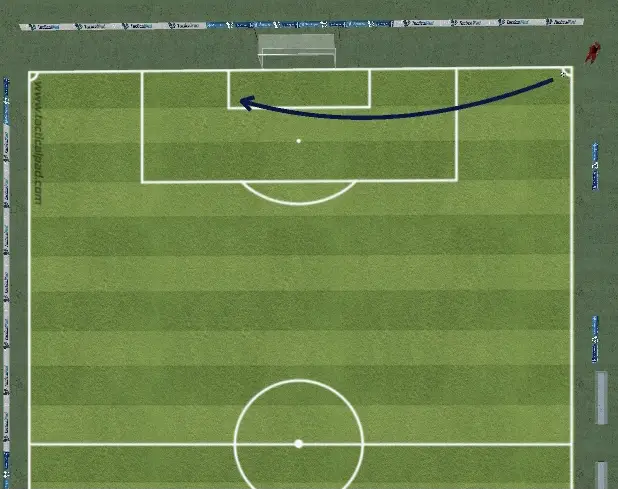
This is where the cross is delivered through the air and curls toward the goal. For an inswinging cross to happen in the right-hand corner a left-footed player must take the corner and for an inswinging cross to occur in the left-hand corner a right-footed player must take the corner.
2. out-swinging corner
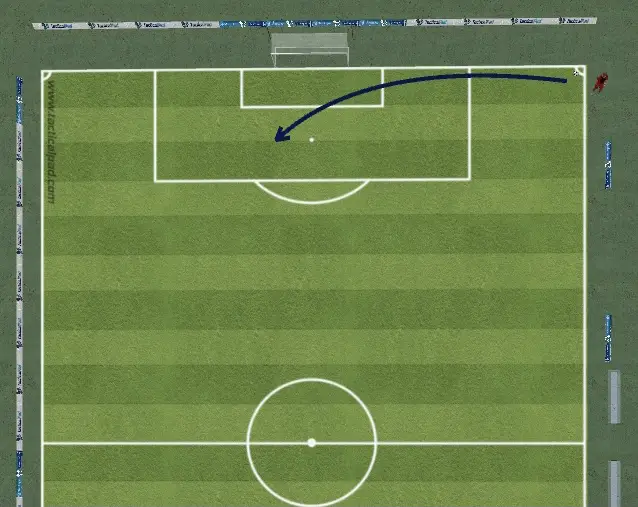
This is when a cross is delivered from the corner in the air that curls away from the goal. For an out-swinging cross to occur a right-footed player must take the corner on the right-hand side or the left-footed player to take the corner on the left-hand side.
3. Straight corner
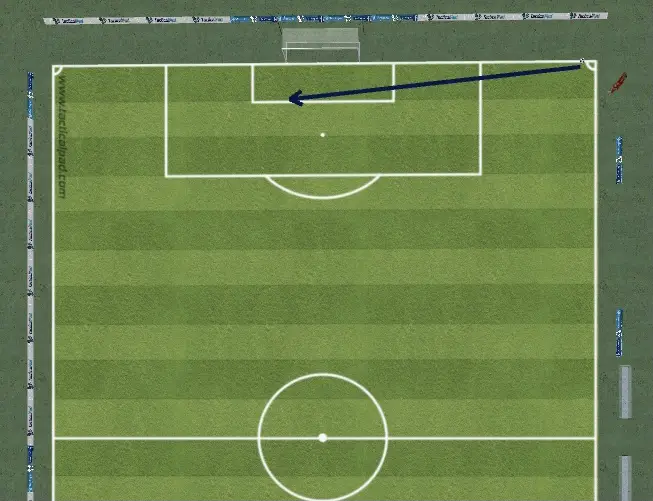
This is used to describe a corner kick that is played in the air without any movement on the ball. The player taking the kick will cross the ball with their laces, striking the ball in the center to avoid curling it.
4. Clipped corner
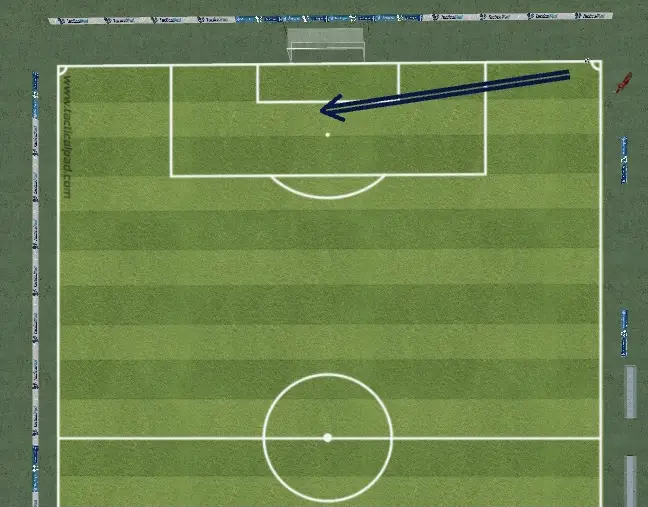
The clipped corner describes a corner that has a higher trajectory with a reduction of speed, players who are attacking this type of cross will have to generate the power themselves for an attempt on goal.
5. Short corner
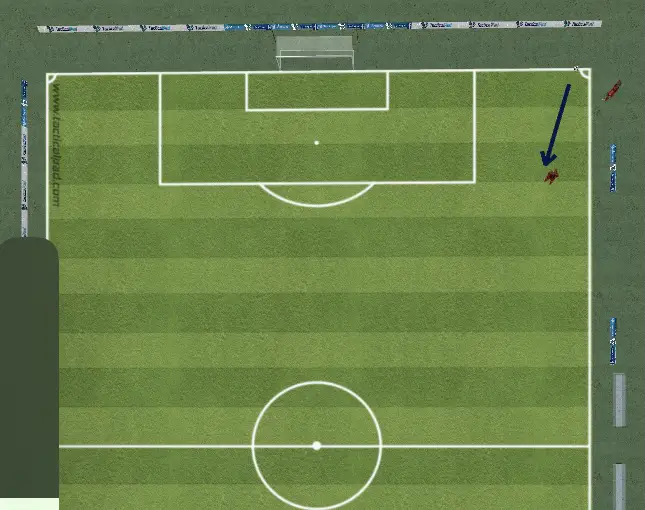
Instead of delivering a cross into the box from the corner, the corner kick taker passes it to a player who is about 5 – 10 yards away to help retain possession and create a more meaningful attack.
One of the reasons why to take short corners is to try and create a better angle for delivering a more dangerous cross, which will usually create a 2v1 in the attacking team’s favor.
The short corner is a great way to catch a team off guard, defending teams will usually expect the corner kick to be crossed straight into the box. This way the attacking team can attack with a greater purpose and precision.
A short corner can also be used to run down the clock, by trying to play keep the ball in the corner and shielding the ball from the opponents. Similar to a free kick, defending players must be 10 yards away from the corner kick when it is taken.
Can you kick a corner directly into the goal?
Yes, this is allowed in soccer. Although this is quite rare it has happened before!
The best way to score from a corner kick in soccer is to take an in-swinging corner kick that bends and loops toward the back post.
This will make it very difficult for the keeper to reach.
Sometimes these types of corners catch the keeper off guards as they are not expecting a player to score from that position.
Which type of corner kick in soccer is the most successful?
To help maximize your soccer team’s opportunities to score goals you need to understand which types of crosses create the most successful changes that can lead to a goal.
Below is a table that shows the different types of corners that occurred during the 48 group-stage games of the 2010 World Cup.
A successful corner for the study was classified as a corner take that lead to an attempt on target.
| Style | Frequency | Successful Outcomes | Success Rate | Goals | Shots on Target | Shots off Target |
| Inswing | 117 | 18 | 15.3% | 2 | 7 | 11 |
| Outswing | 123 | 33 | 26.8% | 2 | 7 | 26 |
| Straight | 101 | 44 | 43.5% | 0 | 18 | 26 |
| Chipped | 10 | 3 | 30.0% | 0 | 1 | 2 |
| Short | 92 | 12 | 13.0% | 0 | 6 | 6 |
The table from the study shows the most frequently occurring corner kick being taken was the out swinging (123) and the inswinging (117).
Both types of corners contributed to 2 goals each and generate 7 shots on target, however overall the out-swinging corner had a higher success rate of 26.8%. This means that for roughly every 4 corners that were taken 1 chance would be created from an out-swinging corner.
Although no goals were scored from a straight corner, this had the third-highest frequency (101) and highest success rate (43.5%).
Chipped crossed had the second-highest success rate (30%) however it was the least frequently used corner type (10).
Below is a graphic that shows the area of the opponent’s half where the attacking teams’ corner kicks went as a percentage.
The numbers in the brackets represent the success rate of a corner being taken towards that area.
The graphic was adjusted so that all corners taken were from the left-hand corner as you are facing the goal.

This graphic shows that most of the corners delivered were in the middle of the box in zones 1, 2, and 3. With the success rate dropping the closer the cross got to the goalkeeper.
The highest success rate came from zone 3 (43%), zone 8 (35%), and zone 5 (32%). However, these areas had the lowest frequency of shots at 5%, 4%, and 6% retrospectively.
It is important to bear in mind that we do not know the quality of the chances that were created, what zones the goals were scored from, or what types of crosses were delivered in which zones.
Credit and reference: Oliver Wrynne-Simpson, Analysis Of The Success Rate Of Corner Kicks and Free Kicks At the 2010 World Cup
Other useful readings on corner statistics:
- Long corner kicks in the english premier league: deliveries into the goal area and critical area
- Notational analysis of corner kicks in English premier league soccer
The best type of corner kick to take in soccer
If we look at the table and graphic above the best type of corner kick based on the percentages to take should be an out-swinging corner that is targeted towards the penalty spot.
Out-swinging corners created more successful chances (15 more shots off target than in-swinging corners) and with the frequency of crosses being delivered to zones 1 and 2 this suggests that there is a higher chance of teams scoring from this position.
However in soccer, especially for set pieces, it is important to keep your opponents guessing so varying types of corners your team takes.
Switching between, in-swinging, out-swinging and straight crosses being delivered to zones 1 – 3 would be the best types of corner kicks to take in soccer as these lead to the most chances created.
Also as a soccer coach consider the stage of the game and scoreline when deciding your corner tactics.
For example, if you are 1-0 with one minute left you may want to play a short corner.
Although short corners created less successful changes in the study, they are a great way to retain possession and look after the ball.
Who should take corner kicks?
Ideally, the player who has the best dead-ball delivery should be the player taking the corner kicks, this player should be able to consistently cross the ball with pinpoint accuracy to specific areas of the opponent’s half.
Depending on your tactics you may need 1 or 2 players with this type of quality.
As a coach, you may only want in-swinging or out-swinging corners which will require a preferred left-footed and right-footed player.
You may also get injuries to these players so make sure you have a backup corner taker in mind.
Try to avoid players taking crosses who have a good jumping ability or who are taller, these players will provide you more of an attacking threat in the opponents’ box when corners are delivered.
My 6 best corner kick Tactics and routines that scores goals
Deciding on what type of corner you should is only half the battle, as coaches, you also have the responsibility of organizing the attacking players who will be trying to score from the cross to make sure 2 players do not go for the same ball.
During attacking corners space in the opposing team’s box can be very crowded, with up to 12 – 14 players in the area meaning it can be difficult for players for space to score.
The aim of corner routines is to create space where the cross will be delivered for the players to attack. This can be through player movement.
As one player moves make a run to a different space dragging a defender with them, this allows for another attacker to move into the space that was just created.
Make sure your players have signals so they know which type of corner kick is expected to be delivered and what area the cross is being aimed for.
The corner kick tactics in soccer below are going to show you different routines you can teach your players that will help them create space for themselves to score more goals from corners.
With each corner tactic, there will be an animated video showing you the routine.
Make sure you have all the soccer coaching equipment you need for these corner tactics before starting.
I go into more detail about how you can create space in soccer in this post
1. 3 players of the edge-of-the-box Corner tactic
This is a very simple yet effective tactic and probably the easiest for you players to get the concept of. The aim of this corner is to have players running to different areas of the box to attack the cross as it comes in.
The player taking the corner must signal to the players
Start your 3 players on the edge of the goalkeeper’s box bunched up.
As the corner is delivered, the players will split up and attack a different area of the box.
One player will go to the front post, another to the back, and one centrally.
For this corner routine to work is important that all players stick to their specific runs and just because the ball is not going to them it does not mean they can switch off.
Make sure they are staying alert to get any rebounded or deflected efforts on goal.
2. Crash the box Corner tactic
This is another simple yet effective corner routine where the 3 players again will start on the edge of the box.
The aim of this cross is to put the ball into a dangerous area with 3 players trying to attack the ball, running in from the edge of the area however 1 player will attack the back post and 2 will attack the central area.
Space in the middle will be created by 2 players who will start in the middle with one player making a run toward the back post and one toward the back post.
This will allow the 3 players on the edge of the box to attack the space in the middle of the box as the corner is delivered to that area.
With a player making a run towards the front and back post it also increases the chances of winning the cross if it is over or under-hit. These players can guide the ball back toward the middle where the 3 players are attacking.
3. Crash the box pull-back Corner tactic
This will be a similar corner routine to the regular crash-the-box, however, with this routine the aim is to create space for a player who could take a shot from in between the penalty spot and the edge of the area.
Instead of 2 players starting from the middle 1, 1 player will start in the middle and make the same run towards the front of the post.
The other player will start the run from the back post, with 3 players starting on the edge of the box.
The player in the middle will make a run toward the front post to create space for the 3 attacking players to attack the space that has been left.
This will be a similar corner routine to the regular crash-the-box, however, with this routine the aim is to create space for a player who could take a shot from in between the penalty spot and the edge of the area.
Instead of 2 players starting from the middle 1, 1 player will start in the middle and make the same run towards the front of the post.
The other player will start the run from the back post, with 3 players starting on the edge of the box.
The player in the middle will make a run toward the front post to create space for the 3 attacking players to attack the space that has been left.
This will create space for the player at the back post to make a run towards the middle to receive the ball from the corner kick for an attempt on goal.
This will create space for the player at the back post to make a run towards the middle to receive the ball from the corner kick for an attempt on goal.
4. Pile the Keeper Corner tactic
This corner kick routine is used to put the keeper under a lot of pressure as the corner kick comes in.
Typically you want to create space for players to attack at a corner, however, with this corner tactic, you want to stand as close to the goalkeeper as possible only a couple of yards away from your teammates.
This will cause a lot of confusion, and communication errors and make it very hard for the keeper to come out and collect the ball.
The more numbers you have in a certain area of the box when the ball is delivered into that area, the higher chance of your team scoring a goal or getting the rebound.
Just be careful that your soccer team does not foul the keeper as they are becoming more protected by the laws of the game when jumping to collect crosses.
5. Short Corner tactic
This is a perfect corner kick routine if you want to create a more dangerous opportunity to score from by giving yourself a better angle to deliver the cross.
A short corner with an overlap would also allow your team to retain possession, especially if the game is heading into the closing stages and you are trying to protect a narrow lead.
To execute this corner tactic 4 players will start on the edge of the box who are looking to attack the middle.
Before the other team has a chance to organize a 1 player will peel off from this group of 4 and create the option for a short pass.
This should now create a 2v1 scenario.
The player who took the corner will not make an overlapping run behind the play who just received the ball.
This gives the player on the ball the chance to dribble past the defender on the outside or cut it back to the play to the corner to cross the ball into the box.
Attackers should be careful with the offside trap, a well-organized defensive team will know to step up when the ball gets played backward.
6. back post header corner tactic
This corner tactic is great if you have tall players on your team or players with good jumping ability.
With this corner, the cross is aimed towards the back post where these players will win the header and either get an attempt off on goal or put the ball back across the box for a teammate to try and score.
It is recommended that the player taking the corner kick is an in-swinger, this is because it will make it easier for the player to attack the ball at the back post with a better chance of winning the ball and the cross is more accurate.
To increase your chances of a player winning the ball at the back post you can have 2 players attack the back post.
The other players should find an area where they could score a goal if the header comes back across the goal or a position where they can win the ball back and put it into a dangerous area if the defenders clear the ball.
Attacking corner kick tactics in Soccer conclusion
In conclusion for attacking corner kick tactics in soccer, the best type of corner to take is the out-swinging corner, as this will help your team create a lot of chances to score goals. It is important to remember that variety is key and that in-swinging and straight corner kicks provide lots of chances to score.
To keep opposition players on their toes should switch up your corner kick routines to make it harder for them to defend against you.
Finally, ensure your players are organized and know their specific role in the routine so they can carry out the corner tactic effectively.
This will increase your chance of scoring goals.
These different corner kick tactics and routines should give your team loads of ideas when taking corning which will hopefully convert more corners into goals!
Do you have any corner kick tactics in soccer that you use with your teams? Feel free to leave a comment.
If you know a coach that would find these corner kick tactics in soccer posts useful then please share it with them using our social media buttons.
Thank you!
Toby
Related Soccer Posts:
- 10 Drills For Crossing and Finishing
- Best Tactics for Defending Corners
- Crossing and Finishing Soccer Session Plan
My Soccer Coaching Equipment
If you opened my coaching bag this is the soccer equipment you’d find!


1 thought on “Attacking Corner Kick Tactics In Soccer | Best Guide”
Comments are closed.